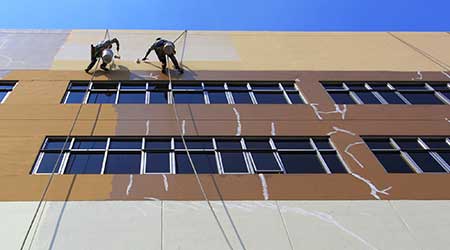 The impact paints and coatings have on operations go far beyond appearance. They are key elements in protecting building structures and components.
The impact paints and coatings have on operations go far beyond appearance. They are key elements in protecting building structures and components. Paints and Coatings: Scheduling Matters
Effective scheduling of paint and coatings projects can make the difference between a successful project and one that isn't.
Timing is everything
Effective scheduling will make the difference between a successful project and one that haunts managers for years. It is absolutely critical that whatever schedule managers establish be appropriate for the type and use of the facility. The objective is to minimize the project’s labor costs and the disruption to activities performed in the impacted space.
If a facility’s use varies by season, managers should schedule work during vacation periods when the use is minimal. Similarly, in facilities with typical nine-to-five operations, scheduling projects during evenings or weekends minimizes disruptions. Even in facilities that never really close, such as hospitals, managers can schedule application projects for periods of time when the use of the particular space is minimal.
Careful scheduling not only minimizes disruptions to the users of the space. It also minimizes interruptions to the project itself. With few or no occupants present, it is less likely that personnel needing to access the space will interrupt the project. Having to work around the activities of building occupants is a major cause of project delays and cost overruns.
Proper scheduling also means managers must be sure all of the tools needed to perform the project are in place before the painting project begins. The tools must match the project. If in-house workers are applying the paint or coating, they must have high-quality rollers, brushes, sprayers, ladders, platforms, and tarps. Here too, quality matters.
High-quality tools are easier to use, perform better, and last longer than lower-quality tools. Remember, labor represents 70 percent of the total cost for most projects. Providing high-quality tools reduces labor costs, which more than offsets the higher cost of the tools and equipment.
Successful scheduling also requires that workers perform a certain level of pre-application work. Depending on the application, it might be necessary to prepare the surface, including patching, sanding rough areas, removing stains and grease, and sealing. If the space’s availability is limited, workers can perform much of it ahead of the planned painting.
Scheduling also requires that managers make arrangements for removing furniture and other items from the space to be painted. HVAC technicians might have to shut down systems to prevent odors from the application making their way into the rest of the facility. Managers also need to identify temporary storage locations and schedule crews to do the moving.
The need for scheduling does not stop with the completion of the application. Managers also must schedule cleanup of the areas impacted, and crews must return items that were moved or put into storage, and technicians need to restore HVAC systems to their normal operations.
All of these tasks take time that managers must build into the project schedule.
Related Topics:














